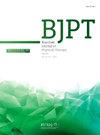与发育正常的同龄人相比,脑瘫儿童的有氧健身情况:系统回顾和荟萃分析。
IF 3.2
3区 医学
Q1 ORTHOPEDICS
引用次数: 0
摘要
背景:在公共卫生领域,有氧健身是预测健康和疾病的重要指标:在公共卫生领域,有氧体能是预测健康和疾病的重要指标:目的:通过最大运动量测试,确定脑瘫(CP)儿童与发育正常(TD)儿童的有氧健康状况:在 PubMed (MEDLINE)、PsycArticles、PsycInfo、CINAHL 和 SPORTDiscus (EBSCO) 中进行了系统的文献检索。纳入的研究均为原始研究,这些研究报道了 18 岁或以下的 CP 儿童在使用气体分析系统进行最大运动测试时的有氧体能结果,以峰值摄氧量(VO2peak)表示。根据最大运动测试类型、粗大运动功能分类系统(GMFCS)水平、CP分布情况和性别,采用通用逆方差法对VO2peak值进行汇总:结果:共纳入了 36 项研究,其中包括 510 名患有 CP(GMFCS I-IV)的儿童和 173 名患有 TD 的儿童。采用自行车测力计测试(16 人)、跑步机运动测试(13 人)、曲臂测力计测试(6 人)、穿梭跑测试(3 人)和穿梭骑行测试(1 人)测量 VO2 峰值。CP患儿的总VO2峰值为32.84 mL/kg/min(SE 1.28),TD患儿为45.02 mL/kg/min(SE 1.32),CP和TD患儿的差异为-12.17 mL/kg/min(95 % CI:-16.70,-7.64)。分组分析显示,GMFCS水平较高的儿童和患有CP的男孩的有氧体能受到的影响最大:结论:CP 患儿的有氧体能受到严重影响。结论:CP 患儿的有氧体能受到严重影响,建议促进 CP 青少年的健康生活方式,并增加他们对体育活动的参与。该研究方案已在 PROSPERO 登记处进行了前瞻性登记,编号为 CRD42021292879。本文章由计算机程序翻译,如有差异,请以英文原文为准。
Aerobic fitness in children with cerebral palsy compared to typically developing peers: A systematic review and meta-analysis
Background
In the public health domain, aerobic fitness is an important predictor of both health and disease.
Objective
To determine aerobic fitness in children with cerebral palsy (CP) compared to typically developing (TD) peers measured with a maximal exercise test.
Methods
A systematic literature search was conducted in PubMed (MEDLINE), PsycArticles, PsycInfo, CINAHL, and SPORTDiscus (EBSCO). Original studies that reported findings on aerobic fitness expressed as peak oxygen uptake (VO2peak) during a maximal exercise test measured with a gas analysis system, in children with CP, aged 18 years or younger, were included. VO2peak values were pooled, using the generic inverse variance method, for type of maximal exercise test, Gross Motor Function Classification System (GMFCS) level, distribution of CP, and sex.
Results
Thirty-six studies with a total of 510 children with CP (GMFCS I-IV) and 173 TD peers were included. VO2peak was measured using cycle ergometer test (n = 16), treadmill exercise test (n = 13), arm crank ergometer test (n = 6), shuttle run test (n = 3), and shuttle ride test (n = 1). The overall pooled VO2peak in children with CP was 32.84 mL/kg/min (SE 1.28) and 45.02 mL/kg/min (SE 1.32) in TD peers, with a difference between CP and TD of -12.17 mL/kg/min (95 % CI: -16.70, -7.64). Subgroup analyses revealed that aerobic fitness was most compromised in children at higher GMFCS levels and boys with CP.
Conclusion
Aerobic fitness is severely compromised in children with CP. Promoting a healthy lifestyle and increasing participation in physical activities for young people with CP is recommended.
The study protocol was prospectively registered in the PROSPERO registry with reference number CRD42021292879.
求助全文
通过发布文献求助,成功后即可免费获取论文全文。
去求助
来源期刊
CiteScore
6.10
自引率
8.80%
发文量
53
审稿时长
74 days
期刊介绍:
The Brazilian Journal of Physical Therapy (BJPT) is the official publication of the Brazilian Society of Physical Therapy Research and Graduate Studies (ABRAPG-Ft). It publishes original research articles on topics related to the areas of physical therapy and rehabilitation sciences, including clinical, basic or applied studies on the assessment, prevention, and treatment of movement disorders.

 求助内容:
求助内容: 应助结果提醒方式:
应助结果提醒方式:


